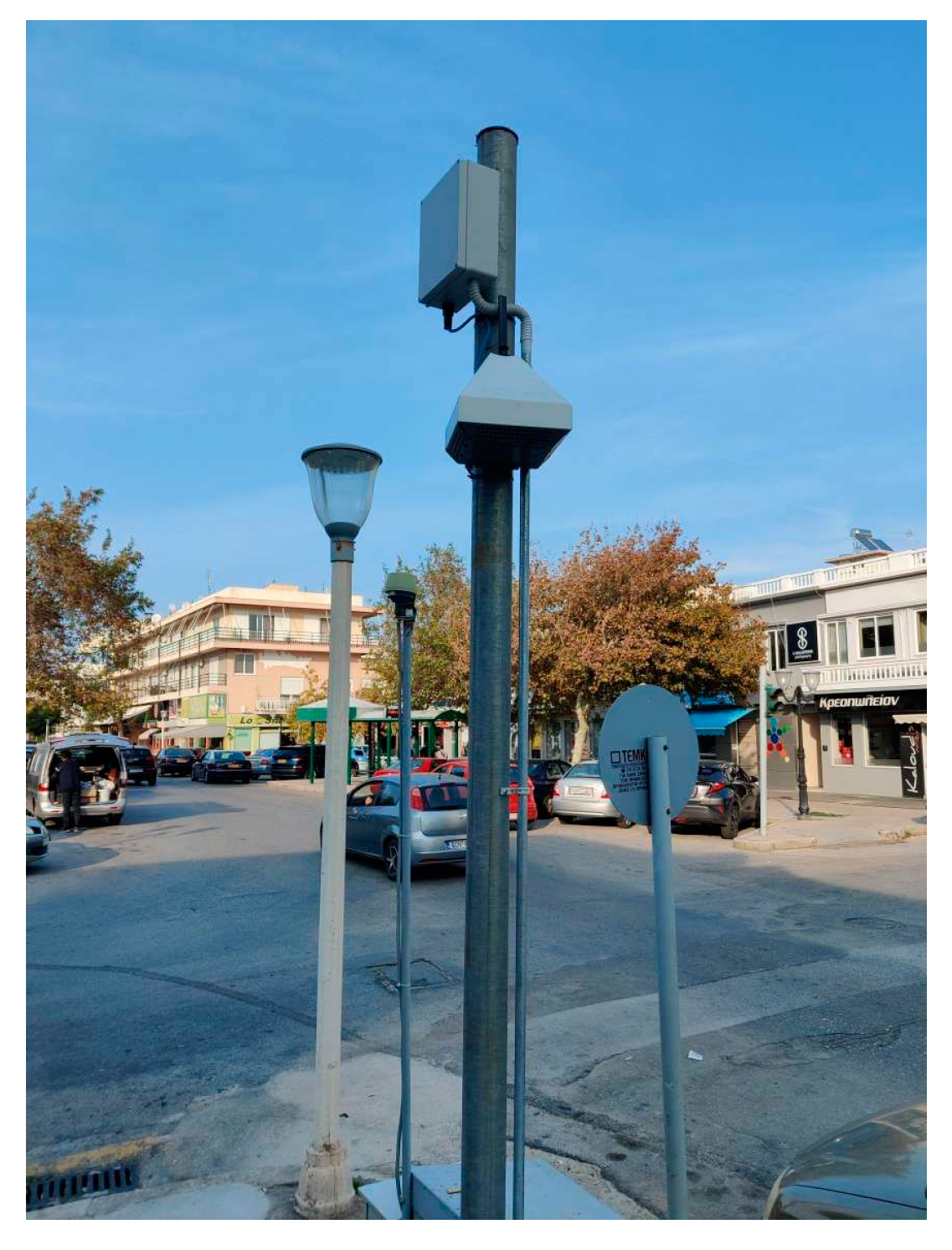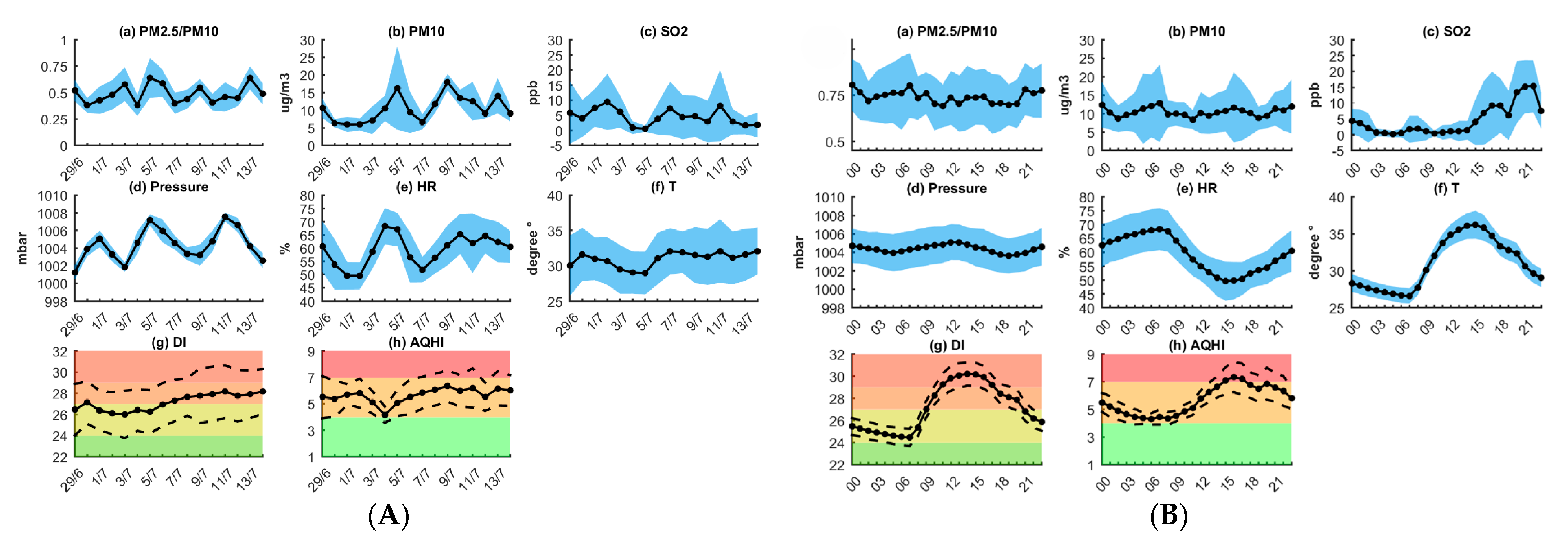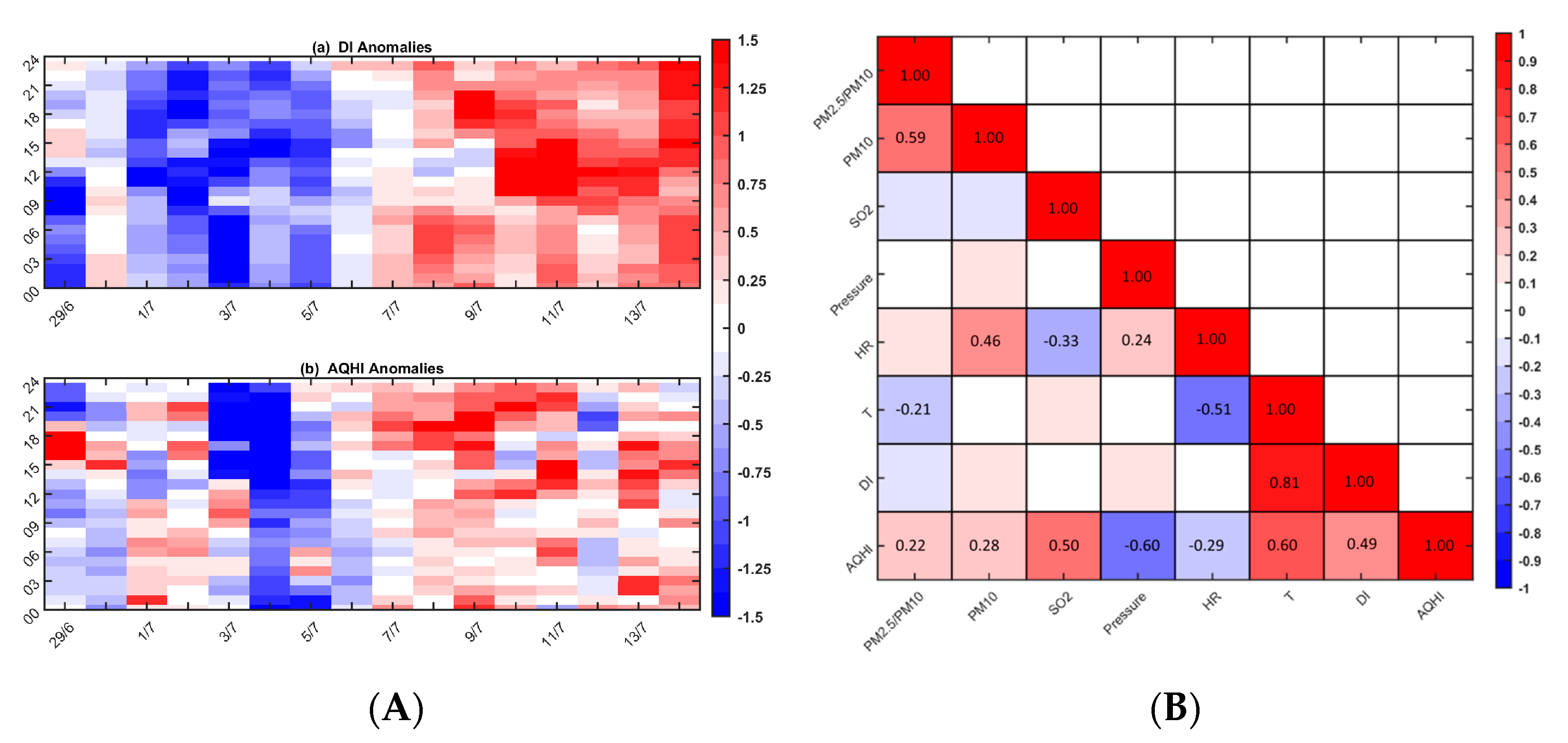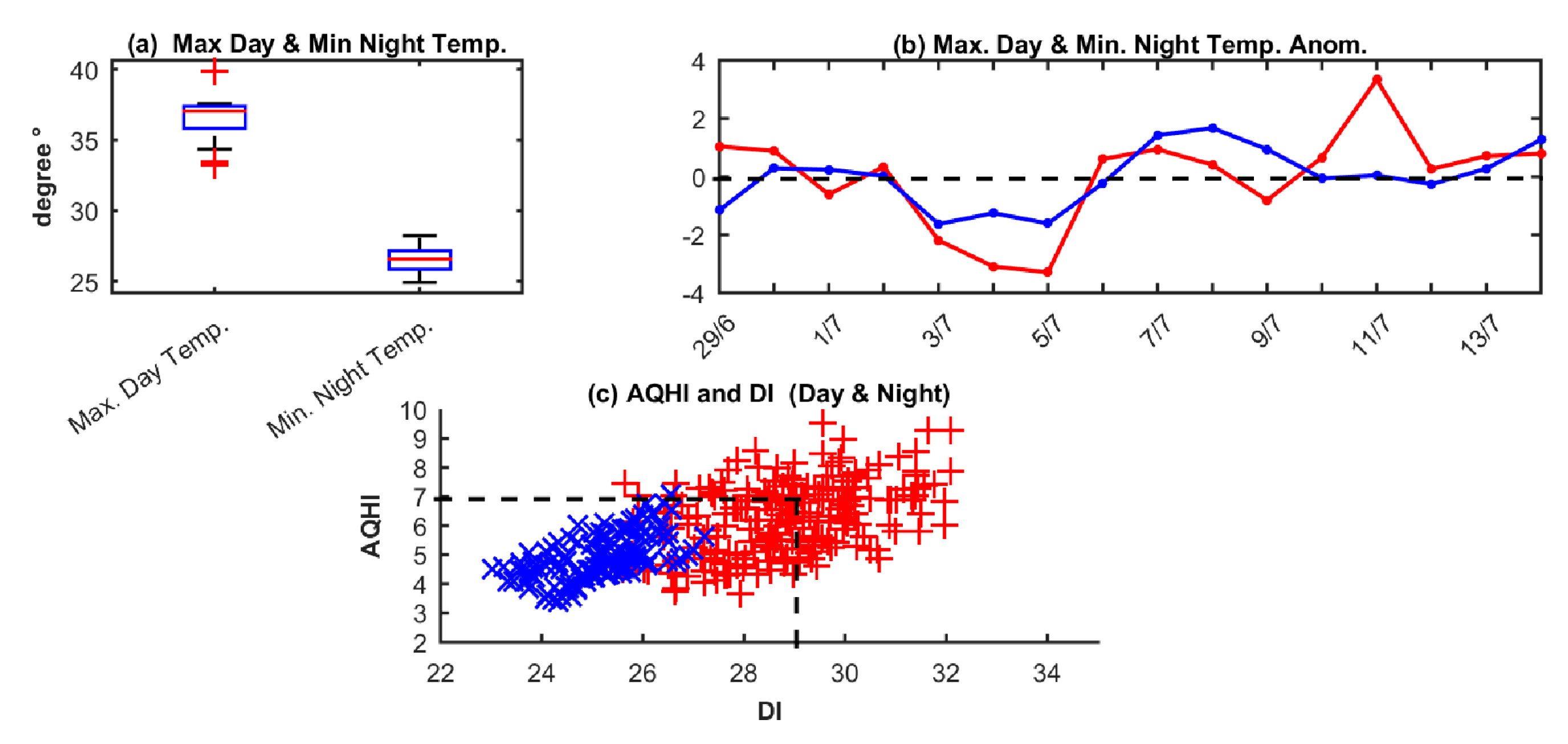Air Quality Health Index and Discomfort Conditions in a Heatwave Episode During July 2024 in Rhodes Island †
Abstract
1. Introduction
2. Materials and Methods
3. Results and Discussion
4. Conclusions
Author Contributions
Funding
Institutional Review Board Statement
Informed Consent Statement
Data Availability Statement
Acknowledgments
Conflicts of Interest
References
- Chen, H.; Oliver, B.G.; Pant, A.; Olivera, A.; Poronnik, P.; Pollock, C.A.; Saad, S. Effects of air pollution on human health—Mechanistic evidence suggested by in vitro and in vivo modelling. Environ. Res. 2022, 212, 113378. [Google Scholar] [CrossRef]
- Manisalidis, I.; Stavropoulou, E.; Stavropoulos, A.; Bezirtzoglou, E. Environmental and Health Impacts of Air Pollution: A Review. Front. Public Health 2020, 8, 505570. [Google Scholar] [CrossRef]
- Mahesti, O.; Tackle Climate Change and Air Pollution Together. United Nations University, UNU Centre, UNU-IAS, 3 January 2024. Available online: https://unu.edu/article/tackle-climate-change-and-air-pollution-together (accessed on 8 August 2024).
- Di Napoli, C.; McGushin, A.; Romanello, M.; Ayeb-Karlsson, S.; Cai, W.; Chambers, J.; Dasgupta, S.; Escobar, L.E.; Kelman, I.; Kjellstrom, T.; et al. Tracking the impacts of climate change on human health via indicators: Lessons from the Lancet Countdown. BMC Public Health 2022, 22, 663. [Google Scholar] [CrossRef] [PubMed]
- Seneviratne, S.I.; Zhang, X.; Adnan, M.; Badi, W.; Dereczynski, C.; Di Luca, A.; Ghosh, S.; Iskander, I.; Kossin, J.; Lewis, S.; et al. Weather and Climate Extreme Events in a Changing Climate (Chapter 11). In Climate Change 2021: The Physical Science Basis. Contribution of Working Group I to the Sixth Assessment Report of the Intergovernmental Panel on Climate Change; Masson-Delmotte, V., Zhai, P., Pirani, A., Connors, S.L., Péan, C., Berger, S., Caud, N., Chen, Y., Glodfarb, L., Gomis, M.I., et al., Eds.; Cambridge University Press: Cambridge, UK; New York, NY, USA, 2021; pp. 1513–1766. [Google Scholar] [CrossRef]
- Logothetis, I.; Tourpali, K.; Melas, D. Projected Changes in Etesians Regime over Eastern Mediterranean in CMIP6 Simulations According to SSP2-4.5 and SSP5-8.5 Scenarios. Environ. Sci. Proc. 2023, 27, 4. [Google Scholar] [CrossRef]
- Logothetis, I.; Tourpali, K.; Melas, D. Future Projections of Cloud Cover and Surface Relative Humidity Over Greece during the 21st Century Based on EURO-CORDEX Simulations. Environ. Sci. Proc. 2022, 19, 46. [Google Scholar] [CrossRef]
- Seker, M.; Gumus, V. Projection of temperature and precipitation in the Mediterranean region through multi-model ensemble from CMIP6. Atmos. Res. 2022, 280, 106440. [Google Scholar] [CrossRef]
- Wedler, M.; Pinto, J.G.; Hochman, A. More frequent, persistent, and deadly heat waves in the 21st century over the Eastern Mediterranean. Sci. Total. Environ. 2023, 870, 161883. [Google Scholar] [CrossRef]
- Pascal, M.; Wagner, V.; Alari, A.; Corso, M.; Le Tertre, A. Extreme heat and acute air pollution episodes: A need for joint public health warnings? Atmos. Environ. 2021, 249, 118249. [Google Scholar] [CrossRef]
- IPCC. Climate Change 2022: Impacts, Adaptation, and Vulnerability. Contribution of Working Group II to the Sixth Assessment Report of the Intergovernmental Panel on Climate Change; Pörtner, H.-O., Roberts, D.C., Tignor, M., Poloczanska, E.S., Mintenbeck, K., Alegría, A., Craig, M., Langsdorf, S., Löschke, S., Möller, V., et al., Eds.; Cambridge University Press: Cambridge, UK; New York, NY, USA, 2022; 3056p. [Google Scholar]
- Logothetis, I.; Antonopoulou, C.; Zisopoulos, G.; Mitsotakis, A.; Grammelis, P. A Case Study of Air Quality and a Health Index over a Port, an Urban and a High-Traffic Location in Rhodes City. Air 2023, 1, 139–158. [Google Scholar] [CrossRef]
- Logothetis, I.; Antonopoulou, C.; Zisopoulos, G.; Mitsotakis, A.; Grammelis, P. The Impact of Climate Conditions and Traffic Emissions on the Pms Variations in Rhodes City during the Summer of 2021. In Proceedings of the 7th World Congress on Civil, Structural, and Environmental Engineering (CSEE’22), Virtual Conference, 10–12 April 2022. Paper No. ICEPTP 181. [Google Scholar]
- Logothetis, I.; Antonopoulou, C.; Zisopoulos, G.; Mitsotakis, A.; Grammelis, P. Changes in Air Quality Health Index in a Coastal City of the Southeastern Aegean Sea between a Summer and Winter Period of 2022. Environ. Sci. Proc. 2023, 27, 13. [Google Scholar] [CrossRef]
- Logothetis, I.; Antonopoulou, C.; Zisopoulos, G.; Mitsotakis, A.; Grammelis, P. Air Quality and Climate Comfort INDICES over the Eastern Mediterranean: The Case of Rhodes City during the Summer of 2021. Environ. Sci. Proc. 2022, 19, 1. [Google Scholar] [CrossRef]
- Yao, J.; Stieb, D.M.; Taylor, E.; Henderson, S.B. Assessment of the Air Quality Health Index (AQHI) and four alternate AQHI-Plus amendments for wildfire seasons in British Columbia. Can. J. Public Health 2020, 111, 96–106. [Google Scholar] [CrossRef]
- Liu, Y.; Zhou, Y.; Lu, J. Exploring the relationship between air pollution and meteorological conditions in China under environmental governance. Sci. Rep. 2020, 10, 14518. [Google Scholar] [CrossRef]
- Poupkou, A.; Nastos, P.; Melas, D.; Zerefos, C. Climatology of Discomfort Index and Air Quality Index in a Large Urban Mediterranean Agglomeration. Water Air Soil Pollut. 2011, 222, 163–183. [Google Scholar] [CrossRef]
- Available online: https://elektron-project.gr/index.php (accessed on 17 August 2024).
- Available online: https://sdgs.un.org/partnerships/gr-eco-islands-initiative-promoting-sustainable-development-green-economy-energy (accessed on 10 August 2024).
- Available online: https://clean-energy-islands.ec.europa.eu/ (accessed on 12 August 2024).
- Available online: https://gsri.gov.gr/wp-content/uploads/2022/11/Synopsis_National-Smart-Specialisation-Strategy-2021-2027.pdf (accessed on 10 September 2024).
- Chrysomallidis, C.; Tsakanikas, A. The implementation of smart specialization strategy in Greece: Re-balancing governance between the central state and the regions. Reg. Sci. Policy Pract. 2017, 9, 183–200. [Google Scholar] [CrossRef]
- Hellenic National Meteorological Service. Available online: https://www.emy.gr/climatic-data?tab=statistics-tab (accessed on 18 January 2025).
- National Collaborating Centre for Environmental Health|NCCEH—CCSNE—Uses and Limitations of Low-Cost Sensors in a Changing Climate. Available online: https://ncceh.ca/resources/blog/uses-and-limitations-low-cost-sensors-changing-climate#h2-4 (accessed on 16 January 2025).
- Bai, L.; Huang, L.; Wang, Z.; Ying, Q.; Zheng, J.; Shi, X.; Hu, J. Long-term Field Evaluation of Low-cost Particulate Matter Sensors in Nanjing. Aerosol Air Q. Res. 2020, 20, 242–253. [Google Scholar] [CrossRef]
- Samad, A.; Obando Nuñez, D.R.; Solis Castillo, G.C.; Laquai, B.; Vogt, U. Effect of Relative Humidity and Air Temperature on the Results Obtained from Low-Cost Gas Sensors for Ambient Air Quality Measurements. Sensors 2020, 20, 5175. [Google Scholar] [CrossRef]
- Giordano, M.R.; Malings, C.; Pandis, S.N.; Presto, A.A.; McNeill, V.F.; Westervelt, D.M.; Beekmann, M.; Subramanian, R. From low-cost sensors to high-quality data: A summary of challenges and best practices for effectively calibrating low-cost particulate matter mass sensors. J. Aerosol Sci. 2021, 158, 105833. [Google Scholar] [CrossRef]
- Liang, L. Calibrating low-cost sensors for ambient air monitoring: Techniques, trends, and challenges. Environ. Res. 2021, 197, 111163. [Google Scholar] [CrossRef]
- De Souza, P.; Kahn, R.; Stockman, T.; Obermann, W.; Crawford, B.; Wang, A.; Crooks, J.; Li, J.; Kinney, P. Calibrating networks of low-cost air quality sensors. Atmos. Meas. Tech. 2022, 15, 6309–6328. [Google Scholar] [CrossRef]
- Nalakurthi, N.V.S.R.; Abimbola, I.; Ahmed, T.; Anton, I.; Riaz, K.; Ibrahim, Q.; Banerjee, A.; Tiwari, A.; Gharbia, S. Challenges and Opportunities in Calibrating Low-Cost Environmental Sensors. Sensors 2024, 24, 3650. [Google Scholar] [CrossRef] [PubMed]
- Cao, R.; Wang, Y.; Huang, J.; Zeng, Q.; Pan, X.; Li, G.; He, T. The construction of the air quality health index (AQHI) and a validity comparison based on three different methods. Environ. Res. 2021, 197, 110987. [Google Scholar] [CrossRef]
- Xu, H.; Hu, X.; Guan, H.; He, G. Development of a fine-scale discomfort index map and its application in measuring living environments using remotely-sensed thermal infrared imagery. Energy Build. 2017, 150, 598–607. [Google Scholar] [CrossRef]
- Lou, C.; Liu, H.; Li, Y.; Peng, Y.; Wang, J.; Dai, L. Relationships of relative humidity with PM2.5 and PM10 in the Yangtze River Delta, China. Environ. Monit. Assess. 2017, 189, 582. [Google Scholar] [CrossRef] [PubMed]
- Zender-Świercz, E.; Galiszewska, B.; Telejko, M.; Starzomska, M. The effect of temperature and humidity of air on the concentration of particulate matter—PM2.5 and PM10. Atmos. Res. 2024, 312, 107733. [Google Scholar] [CrossRef]
- Logothetis, I.; Antonopoulou, C.; Sfetsioris, K.; Mitsotakis, A.; Grammelis, P. Comparison analysis of the effect of high and low port-activity season on air quality in the port of Heraklion. In Proceedings of the 4th International Electronic Conference on Atmospheric Sciences, Online, 16–31 July 2021; MDPI: Basel, Switzerland, 2021. [Google Scholar]
- Su, T.; Li, Z.; Kahn, R. Relationships between the planetary boundary layer height and surface pollutants derived from lidar observations over China: Regional pattern and influencing factors. Atmos. Chem. Phys. 2018, 18, 15921–15935. [Google Scholar] [CrossRef]
- Tyrlis, E.; Lelieveld, J. Climatology and Dynamics of the Summer Etesian Winds over the Eastern Mediterranean. J. Atmos. Sci. 2013, 70, 3374–3396. [Google Scholar] [CrossRef]
- Logothetis, I.; Tourpali, K.; Misios, S.; Zanis, P. Etesians and the summer circulation over East Mediterranean in Coupled Model Intercomparison Project Phase 5 simulations: Connections to the Indian summer monsoon. Int. J. Climatol. 2020, 40, 1118–1131. [Google Scholar] [CrossRef]




| Class Number | DI (°C) | Discomfort Conditions |
|---|---|---|
| 1 | DI < 21 | No discomfort. |
| 2 | 21 ≤ DI < 24 | Less than half of the population feels discomfort. |
| 3 | 24 ≤ DI < 27 | More than half of the population feels discomfort. |
| 4 | 27 ≤ DI < 29 | Most of the population suffers discomfort. |
| 5 | 29 ≤ DI < 32 | Everyone feels severe stress. |
| 6 | DI ≥ 32 | State of medical emergency. |
| Health Risk | Air Quality Health Index (AQHI) | Health Suggestions | |
|---|---|---|---|
| Sensitive Population | General Population | ||
| Low | 1–3 | Enjoy your usual outdoor activities. | Ideal air quality for outdoor activities. |
| Moderate | 4–6 | Consider reducing or rescheduling strenuous activities outdoors if you are experiencing symptoms. | No need to modify your usual outdoor activities unless you experience symptoms such as coughing and throat irritation. |
| High | 7–10 | Reduce or reschedule strenuous activities outdoors. Children and the elderly should also take it easy. | Consider reducing or rescheduling strenuous activities outdoors if you experience symptoms such as coughing and throat irritation. |
| Very High | >10 | Avoid strenuous activities outdoors. Children and the elderly should also avoid outdoor physical exertion. | Reduce or reschedule strenuous activities outdoors, especially if you experience symptoms such as coughing and throat irritation. |
Disclaimer/Publisher’s Note: The statements, opinions and data contained in all publications are solely those of the individual author(s) and contributor(s) and not of MDPI and/or the editor(s). MDPI and/or the editor(s) disclaim responsibility for any injury to people or property resulting from any ideas, methods, instructions or products referred to in the content. |
© 2025 by the authors. Licensee MDPI, Basel, Switzerland. This article is an open access article distributed under the terms and conditions of the Creative Commons Attribution (CC BY) license (https://creativecommons.org/licenses/by/4.0/).
Share and Cite
Logothetis, I.; Mitsotakis, A.; Grammelis, P. Air Quality Health Index and Discomfort Conditions in a Heatwave Episode During July 2024 in Rhodes Island. Eng. Proc. 2025, 87, 59. https://doi.org/10.3390/engproc2025087059
Logothetis I, Mitsotakis A, Grammelis P. Air Quality Health Index and Discomfort Conditions in a Heatwave Episode During July 2024 in Rhodes Island. Engineering Proceedings. 2025; 87(1):59. https://doi.org/10.3390/engproc2025087059
Chicago/Turabian StyleLogothetis, Ioannis, Adamantios Mitsotakis, and Panagiotis Grammelis. 2025. "Air Quality Health Index and Discomfort Conditions in a Heatwave Episode During July 2024 in Rhodes Island" Engineering Proceedings 87, no. 1: 59. https://doi.org/10.3390/engproc2025087059
APA StyleLogothetis, I., Mitsotakis, A., & Grammelis, P. (2025). Air Quality Health Index and Discomfort Conditions in a Heatwave Episode During July 2024 in Rhodes Island. Engineering Proceedings, 87(1), 59. https://doi.org/10.3390/engproc2025087059








